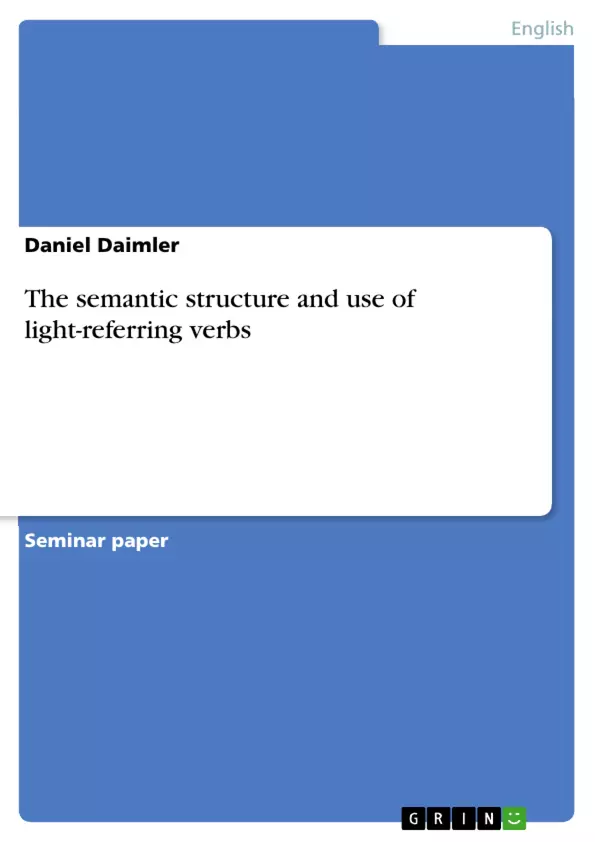Introduction
I.1. General introduction
The phenomenon “light” is without any doubt the most driving force of live itself : it provides energy to the photosynthsesis and influences the biological rhythm of any living creature on earth.
The nature and potential of light is one of the major topics of all “hard” sciences, such as biology, physics, chemistry and astronomy, and still, there has not been found any consensus about its actual consistency to be agreed upon yet.
But how does the concept LIGHT show up in human language? How do
human beings describe the perception of brightness and by which criteria do we distinguish? Do we use the concept metaphorically, and if, to which extent?
However, we will have to keep in mind, that the actual reference, this is perceiving light, is -in an anthropological way - much older than its linguistic expression.
Within this termpaper I will try to `throw light on´ this subject and to answer the following questions.
[...]
Inhaltsverzeichnis (Table of Contents)
- I. Introduction
- I.1. General introduction
- 1.2 Research questions in detail
- II. Methodology
- II.1 Data ressources
- II.2 Methodology in detail
- III. Results
- III.1 Lexical analysis
- III.1.1 Semantic features
- III.1.2 German lexemes
- III.1.3 English lexemes
- III.1.4 Summary
- III.2 Analysis of collocations
- III.2.1 German collocations
- III.2.1.1 Summary
- III.2.2 English collocations
- III.2.2.1 Summary
- III.2.1 German collocations
- III.3 Final discussion
- III.1 Lexical analysis
Zielsetzung und Themenschwerpunkte (Objectives and Key Themes)
This term paper aims to compare the semantic structure and communicative use of light-referring verbs in German and English. It seeks to determine similarities and differences between the two languages in terms of these verbs' semantic features, hierarchical structures, and metaphorical use. The paper will also analyze the extent to which these lexemes are used in collocations and identify potential restrictions in their use.
- Comparison of the semantic structure of light-referring verbs in German and English
- Analysis of the communicative use of light-referring verbs in both languages
- Investigation of the metaphorical use of the concept "EMITTING LIGHT" in German and English
- Examination of the use of these lexemes in collocations and identification of potential restrictions
- Comparison of the concepts of "spreading brightness" in German and English
Zusammenfassung der Kapitel (Chapter Summaries)
- I. Introduction: This chapter introduces the concept of light and its importance in various sciences. It poses research questions that focus on comparing light-referring verbs in German and English, including their semantic features, hierarchical structures, metaphorical uses, and collocations.
- II. Methodology: This chapter outlines the data resources and methodology used in the research. It discusses the selection of German and English lexemes, their synonyms, and the sources consulted for the analysis. The chapter also explains the qualitative analysis approach, including the identification of binary semantic features and the analysis of word combinations.
- III. Results: This chapter presents the findings of the lexical analysis, including the semantic features of the selected verbs and their use in German and English. It further analyzes the collocations of these verbs in both languages, focusing on identifying common patterns and potential metaphors.
Schlüsselwörter (Keywords)
This study focuses on light-referring verbs in German and English, investigating their semantic structures, communicative uses, metaphorical potential, and collocations. The research delves into semantic features, hierarchical structures, and the concept of "spreading brightness" in both languages. Key concepts explored include lexical analysis, collocations, and cross-linguistic comparison.
- Quote paper
- M.A. Daniel Daimler (Author), 2001, The semantic structure and use of light-referring verbs, Munich, GRIN Verlag, https://www.grin.com/document/3155



